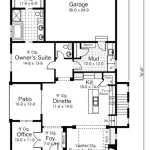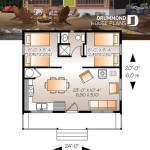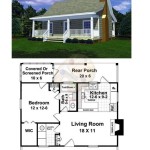How To Create A Floor Plan Of Your House
Creating a floor plan of your house is a valuable undertaking, serving purposes ranging from interior design and renovation planning to insurance documentation and real estate listings. A detailed floor plan provides a visual representation of your home's layout, dimensions, and features, allowing you to experiment with furniture arrangements, visualize potential renovations, and communicate spatial information effectively. This article outlines a comprehensive guide to creating an accurate and informative floor plan of your house, covering various methods and tools available.
Understanding the Purpose and Scope
Before commencing the creation of a floor plan, it's crucial to define its intended purpose and scope. This will influence the level of detail required and the tools best suited for the task. Are you creating the floor plan for personal use, such as rearranging furniture or planning a small renovation? Or is it for professional purposes, such as obtaining building permits, selling your house, or collaborating with architects and contractors? If the floor plan is for professional use, accuracy and adherence to specific standards become paramount. Determine which elements need to be included, such as wall thicknesses, door and window locations and sizes, electrical outlets, plumbing fixtures, and appliance positions.
Consider the overall scope of the project. Will the floor plan encompass the entire house, including all floors and exterior features? Or will it focus on specific rooms or areas? Defining the scope beforehand will help streamline the process and ensure that you gather all the necessary information.
Gathering Measurement Data
Accurate measurements are the foundation of any reliable floor plan. There are several methods for obtaining these measurements, each with its own advantages and disadvantages.
Manual Measurement with Tape Measure: This is the most traditional method, requiring a tape measure, a notepad, and a pencil. It involves physically measuring each room and feature, recording the dimensions on the notepad. While this method is accessible and inexpensive, it can be time-consuming and prone to errors, especially in complex spaces or when dealing with obstructions.
Laser Distance Measurer: This device uses a laser beam to accurately measure distances, making it much faster and more precise than a tape measure. Laser distance measurers are particularly useful for measuring large rooms and distances that are difficult to reach with a tape measure. However, they can struggle with reflective surfaces and may require multiple measurements to account for obstacles.
Digital Measuring Tools and Apps: Several smartphone apps and dedicated digital measuring tools utilize augmented reality (AR) or laser technology to create floor plans. These tools often allow you to scan a room with your device's camera, automatically generating a floor plan with accurate measurements. While these apps can be convenient and efficient, their accuracy can vary depending on the device and the ambient lighting conditions. Always cross-reference the measurements taken with these apps to ensure the accuracy of the drawing.
When taking measurements, it's important to follow a systematic approach. Start by measuring the perimeter of each room, then measure the length and width of all walls, doors, and windows. Note the location of any permanent fixtures, such as fireplaces, built-in cabinets, and plumbing fixtures. Pay close attention to angles and irregularities in the walls, and record these accurately.
Document all measurements meticulously, using a consistent unit of measurement (e.g., inches, feet, meters). Create a rough sketch of each room to help organize your measurements and ensure that you haven't missed anything. Double-check all measurements to minimize errors.
Choosing the Right Software or Tool for Drafting
Once you have gathered all the necessary measurement data, the next step is to choose a software or tool to create the floor plan. There are various options available, ranging from free online tools to professional-grade CAD software. The choice depends on your budget, technical skills, and the level of detail required.
Pencil and Paper: For simple floor plans or preliminary sketches, pencil and paper can be a viable option. This method is inexpensive and requires no specialized software. However, it can be difficult to create accurate and professional-looking floor plans, and it's challenging to make revisions or share the floor plan digitally.
Online Floor Plan Builders: Numerous online floor plan builders offer user-friendly interfaces and pre-designed templates, making it easy to create basic floor plans. These tools typically allow you to drag and drop walls, doors, windows, and furniture, and they often provide options for adding labels, dimensions, and annotations. Many online floor plan builders offer a free version with limited features, as well as paid subscriptions for more advanced functionality.
2D CAD Software: 2D Computer-Aided Design (CAD) software provides a more powerful and flexible environment for creating floor plans. These programs offer a wide range of drawing tools and features, allowing you to create highly accurate and detailed floor plans. 2D CAD software is commonly used by architects, designers, and contractors. Popular options include AutoCAD LT and DraftSight. These options often involve a purchase fee and require some technical knowledge to effectively use.
3D CAD Software: 3D CAD software allows you to create three-dimensional models of your house, providing a more realistic and immersive representation. These programs offer advanced features such as rendering, lighting, and animation, allowing you to visualize your design in detail. 3D CAD software is particularly useful for planning renovations and visualizing interior design options. Popular options include SketchUp, Revit, and ArchiCAD. Like 2D options, these programs involve a purchase fee and require some technical knowledge.
When choosing a software or tool, consider its ease of use, features, compatibility with other software, and cost. Experiment with different options to find the one that best suits your needs and skill level.
Drafting the Floor Plan
With your measurement data and chosen software or tool in hand, you can begin drafting the floor plan. Start by creating the basic outline of the house, including the exterior walls and overall shape. Use the most accurate measurements available to ensure that the outline is as precise as possible.
Next, add the interior walls, doors, and windows. Use your measurements to position these elements accurately, paying attention to their size and placement. Consider the thickness of the walls, as this can affect the overall dimensions of the rooms.
Add any permanent fixtures, such as fireplaces, built-in cabinets, and plumbing fixtures. These elements are crucial for accurately representing the layout of the house. Also, note the placement of any electrical outlets, light switches, and other utilities.
Once the basic layout is complete, add labels, dimensions, and annotations to the floor plan. Label each room with its name (e.g., living room, kitchen, bedroom). Add dimensions to the walls, doors, and windows to provide accurate measurements. Annotations can be used to add notes about specific features or materials.
Ensuring Accuracy and Completeness
Accuracy is paramount in any floor plan. Regularly review and verify your measurements and drawings to minimize errors. Use a checklist to ensure that you have included all the necessary elements, such as walls, doors, windows, fixtures, and annotations. Double-check the dimensions and labels to ensure that they are accurate and consistent.
If possible, compare your floor plan to existing architectural drawings or blueprints of your house. This can help identify any discrepancies in your measurements or drawings. If you are unsure about any aspect of the floor plan, consult with a professional architect or draftsperson.
Walk through your house with the floor plan in hand, comparing the drawing to the actual layout. This can help identify any errors or omissions that you may have missed. Make any necessary corrections or additions to the floor plan.
For professional purposes, it may be necessary to have the floor plan certified by a qualified professional. This ensures that the floor plan meets specific standards and regulations. The certification can also provide added credibility and assurance to potential buyers or contractors.
Refining and Enhancing the Floor Plan
Once you are satisfied with the accuracy and completeness of the floor plan, you can refine and enhance it to improve its visual appeal and functionality. This may involve adding furniture symbols, color-coding rooms, or creating a 3D model.
Adding furniture symbols can help visualize the layout of the rooms and experiment with different furniture arrangements. Use standard furniture symbols to represent different types of furniture, such as sofas, chairs, tables, and beds. Position the furniture symbols accurately within the rooms, taking into account their size and shape.
Color-coding rooms can help differentiate between different areas of the house and make the floor plan easier to read. Use different colors to represent different types of rooms, such as living spaces, bedrooms, bathrooms, and kitchens. Choose colors that are visually appealing and easy to distinguish from each other.
Creating a 3D model of the house can provide a more realistic and immersive representation. This can be particularly useful for planning renovations and visualizing interior design options. Use 3D CAD software to create a three-dimensional model of the house, adding textures, colors, and lighting to enhance its realism.
Consider adding details like landscaping, patios, or decks to the exterior of the floor plan. This can provide a more complete and comprehensive representation of the property.
By following these steps, you can create an accurate and informative floor plan of your house that serves your intended purpose. Remember to prioritize accuracy, completeness, and clarity in your floor plan.

Floor Plans Learn How To Design And Plan

Floor Plan Creator And Designer Free Easy App

Make Your Own Blueprint How To Draw Floor Plans

Draw Floor Plans With The Roomsketcher App

Floor Plans Learn How To Design And Plan

House Plans How To Design Your Home Plan

How To Draw A Floor Plan Live Home 3d

How To Create A Floor Plan And Furniture Layout

Easy To Build Houses And Floor Plans Houseplans Blog Com

House Plans How To Design Your Home Plan
Related Posts








